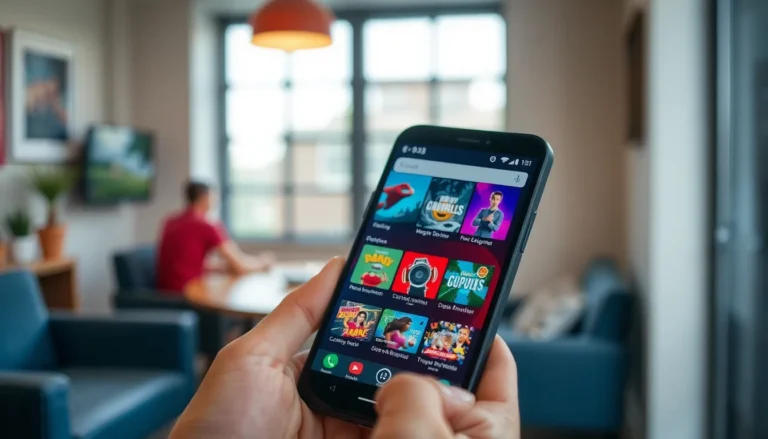Ever found yourself in a hilarious situation on your iPhone that you’d love to capture? Maybe it’s that epic game win or a funny video call mishap. Screen recording on an iPhone is like having a magic wand for your digital life, allowing users to save those unforgettable moments with just a few taps.
Table of Contents
ToggleUnderstanding Screen Recording
Screen recording on an iPhone allows users to capture video of their device’s display. This feature offers a convenient way to document activities and share them with others.
What Is Screen Recording?
Screen recording captures actions on an iPhone screen, creating a video file of any activity. Users can record app usage, gameplay, or tutorials. This function provides instant replay of interactions, showcasing navigations and visual content. Accessing this feature is straightforward, requiring only a few taps in the settings menu.
Benefits of Screen Recording on iPhone
Screen recording enhances communication by allowing individuals to share experiences visually. Anyone can create tutorials for complicated apps, making learning easier for others. Capturing gameplay moments adds excitement for gamers, letting them showcase skills or memorable achievements. The feature simplifies troubleshooting, enabling users to demonstrate issues to support teams. Lastly, it preserves memories from video calls or events, providing a keepsake of shared moments.
How to Enable Screen Recording on iPhone
Enabling screen recording on an iPhone is a simple process that enhances user experience. With just a few taps, users can access this powerful tool.
Accessing Control Center
To access the Control Center, swipe down from the top-right corner of the screen on iPhones with Face ID. For models with a Home button, swipe up from the bottom edge. Look for the screen recording icon, which resembles a filled circle with a dot inside. Tapping this icon starts the recording process quickly. Additionally, users can customize the Control Center by adding the screen recording feature through Settings. Finding the Control Center adds convenience for quick access during activities.
Adjusting Settings
Adjusting settings for screen recording ensures optimal functionality. To start, navigate to Settings, then tap on Control Center. Add Screen Recording to the included controls list for easier access. Users can also adjust microphone settings by long-pressing the screen recording icon in the Control Center. Turning on the microphone allows voice recording during the session. Selecting the appropriate settings enhances recording quality and captures specific audio elements. With these adjustments, screen recordings become tailored for various needs, whether for gameplay or tutorials.
Performing Screen Recording on iPhone
Screen recording on an iPhone is straightforward. This feature offers users the ability to easily capture their screen activities for sharing or personal use.
Starting a Screen Recording
To begin a screen recording, first access the Control Center. Users can swipe down from the top-right corner on Face ID devices or swipe up from the bottom on models with a Home button. Next, tap the screen recording icon, which looks like a filled circle with a dot inside. Once tapped, a countdown from three seconds appears, giving users time to prepare. After the countdown, the recording will start. Notifications will appear, indicating that recording is active. Users can also long-press the icon to access additional options, such as enabling microphone audio. This optional feature is beneficial for creating more dynamic recordings, especially for tutorials or commentary.
Stopping a Screen Recording
Users can stop a screen recording easily. Tapping the red status bar at the top of the screen triggers a prompt to stop the recording. Alternatively, the Control Center can be accessed again, and the screen recording icon can be tapped once more. Upon stopping, a notification will confirm that the recording has been saved to the Photos app. This process ensures users conveniently manage their recorded files without hassle. Checking the Photos app allows users to view, edit, or share their screen recordings easily.
Tips for Effective Screen Recording
Screen recording on an iPhone can provide enhanced experiences when done thoughtfully. Users can optimize their recordings with the right settings and editing techniques.
Audio Settings
Choosing optimal audio settings significantly improves the quality of screen recordings. Users can enable the microphone to record their voice alongside the screen activity. This feature adds context to tutorials or gameplay commentary. Accessing audio settings occurs through the Control Center, making adjustments simple. Users must ensure the microphone icon is highlighted in red before starting. Background sounds, including system audio, also enhance viewer engagement. Balancing audio levels helps maintain clarity, whether recording music apps or discussions during a video call.
Editing Your Screen Recordings
Editing screen recordings offers opportunities to refine content before sharing. Users can trim clips directly within the Photos app to remove unnecessary parts. Adding annotations or text can help emphasize key points, improving viewer comprehension. Applying filters, if desired, can enhance visual appeal and style. Using third-party editing apps can expand creative options for personalized touch. Once editing is complete, sharing works becomes effortless through various platforms, boosting audience engagement. Properly edited recordings convey messages more effectively, creating a polished final product.
Screen recording on an iPhone opens up a world of possibilities for users to capture and share their digital experiences. Whether it’s for documenting a tutorial or preserving a cherished moment, this feature is simple to use and highly effective. By customizing settings and utilizing editing tools, users can create engaging content that resonates with their audience. With just a few taps, anyone can transform their iPhone into a powerful recording device. Embracing this functionality not only enhances communication but also enriches the overall user experience.




